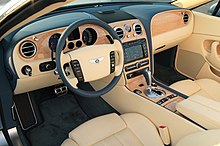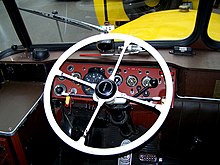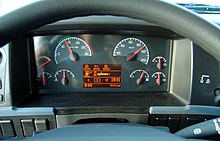dashboard



A dashboard is a display or instrument panel with measuring indicators and operating levers ( armatures ) of a machine. Even if, with a few exceptions, the instruments in cars are no longer mounted on a board, this is referred to as a dashboard, and in the past also as a control panel. On a truck , it is often referred to as the instrument panel .
In the following, this article describes a dashboard in a Central European car designed for right-hand traffic without any particular restrictions, such as a design-related maximum speed. In countries with left-hand traffic such as Great Britain and Japan , the arrangement is partially reversed. In Germany , the road traffic licensing regulations prescribe some of the instruments and facilities.
Instruments
In principle, the important instruments are arranged centrally in the driver's field of vision. In most modern cars, they are combined in a so-called instrument cluster above the steering column .
In any case, a speedometer to display the speed with a built-in odometer (correct: odometer ) is to be found here ( in Germany § 57 StVZO ). There also are warning lights for direction indicator (often separated for directions), high beam , alternator , also still on most vehicles oil pressure and other warning lights on the vehicle condition, the ads for the fuel stock, crankshaft speed (display of revolutions per minute, marking 1 / min or min -1 , in older vehicles also / min U , UPM in imported vehicles rpm , r / min, Giri or Об / мин; often with "x 100" or "× 1000" since the markers only one - or are labeled with two digits), trip meter or increasingly the display of the on-board computer. In older models, an econometer can be provided to display the state of consumption. In vehicles with automatic transmissions, there is often a mechanical or electronic display of the gear currently engaged. There may be additional indicator lights such as for an applied parking brake or non-fastened seat belts .
Digital display
For a number of years there has been a trend towards fully digital displays, or number displays, which are often located in the center of the dashboard. The usefulness of such instruments is controversial, in particular some critics are of the opinion that analog instruments can be grasped more intuitively and do not distract the driver as much. On the other hand, there is the possibility of numbers being hidden by the pointer in analog displays. For some manufacturers, fully digital speed displays were little more than fads; General Motors vehicles were e.g. B. widely equipped with it in the 1990s, but in recent years there has been a return to analog displays.
Head-Up Display
Head-up displays are a new development ; they use lens and mirror systems to display the displays directly on the windshield in the driver's field of vision. This display usually supplements the conventional displays on the dashboard that are still available.
steering wheel
Close to the steering wheel are mostly the levers for the direction indicator , often in combination with the switch for the high beam and the headlight flasher , as well as for the windshield wiper . Depending on the equipment, age and type of vehicle, other levers are installed in addition to these two levers, for example for vehicle lighting or a cruise control . However, these operating elements can also be combined to form what are known as operating satellites . The middle part of the steering wheel is often provided with an airbag and also serves as a switch for the signal horn (" horn "). With some manufacturers, however, the horn is controlled via separate push buttons directly on the steering wheel. Others equip the steering wheel with additional controls; for example controls for the car radio or car phone .
In older vehicles, the switch for the hazard warning lights is often mounted on the top of the steering column. The steering wheel itself can be adjusted in height or width on most new vehicles in order to offer the driver more comfort and to counteract fatigue . A popular extra is also an electric steering wheel adjustment.
Surroundings
Outside of this central area, namely in the center console , there are other controls that the driver must reach. This includes, for example, the switches for lighting , heating ( this is prescribed in Germany in Section 35 c of the StVZO ) or air conditioning , car radio , electric window lifters, if they are not housed in the doors, and the rear window heating . In more modern vehicles, the switch for the hazard warning lights is often located in the center of the dashboard and clearly highlighted so that the passenger can find and operate the switch in an emergency. A switch can also be provided here for the central locking.
The fuses for the on- board electrics are usually mounted below the dashboard, more rarely in the engine compartment of the vehicle . In the footwell there are usually three pedals ( accelerator , brake and clutch ) installed; The clutch pedal is not required for vehicles with automatic transmission. With some manufacturers, such as Mercedes-Benz , the parking brake is not operated as a handbrake, but rather via a pedal . There is also usually the release for the bonnet; the remote unlocking for the tank lid and trunk are usually attached to the side sill.
Shift / gearbox
The gearshift lever is usually located on the transmission tunnel below the dashboard. This version of the shift lever is also called stick or middle shift. The disadvantage of this arrangement is that the passage from the driver's seat to the front passenger seat is not free.
In order to allow free passage and possibly three seats in the front row, gearshifts with a gearshift lever on the steering column were developed, the steering wheel gearshift , as found primarily in US vehicles and also in many European cars of the 1950s and 1960s. The automatic selector lever is also on the steering column in some current models such as the BMW 7 Series or the M-Class from Mercedes-Benz . Pre-selection gears, which were widespread in the 1930s, only have a few centimeters large shift levers on the steering column or in the dashboard for changing gears, as did the Goggomobil later on .
In the so-called revolver or crutch shifting of some cars with front-wheel drive, the gearshift lever is mounted in the dashboard. In vehicles with longitudinally installed engines, for example Citroën 2CV and Renault R 4 , it sits in the middle of the dashboard, in vehicles with transverse engines, for example Lloyd and the Trabant , it is arranged parallel to and on the steering column. These shifts required a less complicated linkage to the gearbox far forward than a center shift.
Parking brake
Some manufacturers, such as Citroën (GSA), Volkswagen (Type 2 T2) or Honda (CR-V), have also installed the parking brake in the dashboard of their vehicles. The vehicles were often equipped with hand brakes that were fitted below the dashboard to the left or right of the steering column. Modern vehicles are increasingly being supplied with electric hand brakes . However, these have the disadvantage compared to a conventional handbrake that you can no longer meter the braking force with them.
Others
The dashboard is completed by the many things that are only secondary to the operation of the vehicle. Limits are only set by the imagination of the vehicle manufacturer or owner . A common type of speakers and air vents, an ashtray , cigarette lighter (which usually serves as a socket for 12 volt appliances), a holder for a mobile telephone (analog or digital), a clock, passenger airbag, a glove box and additional trays and cup holders. Recently, more and more car air conditioning systems and navigation systems have appeared.
Special
- In vehicles with a tachograph , the speedometer is linked to it and often combined in one device.
- In taxis , the taximeter is also on the dashboard (in new vehicles it is partly integrated in the rear-view mirror ).
- The English name dashboard comes from its original function as a splash wall : It was a "board" that protected the driver from dashed up dirt .
See also
literature
- Hans-Hermann Braess, Ulrich Seiffert: Vieweg manual automotive technology. 2nd edition, Friedrich Vieweg & Sohn Verlagsgesellschaft, Braunschweig / Wiesbaden 2001, ISBN 3-528-13114-4 .
Individual evidence
- ^ Franz-Rudolf Esch: Strategy and technology of automobile marketing . Springer Gabler, Oestrich-Winkel 2013, ISBN 978-3-8349-3391-1 , p. 111 .




